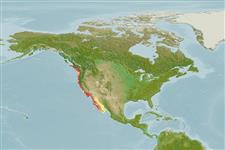Lớp phụ (Subclass) cá vây tia >
Clupeiformes (Herrings) >
Engraulidae (Anchovies) > Engraulinae
Etymology: Engraulis: Greek, eggraulis, -eos = anchovy (Ref. 45335); mordax: Genus name from the Greek 'engraulis' meaning anchovy; species name from the Latin 'mordax' meaning biting (Ref. 27436). More on author: Girard.
Môi trường / Khí hậu / Phạm vi
Sinh thái học
; Biển; Mức độ sâu 0 - 310 m (Ref. 96339), usually ? - 219 m (Ref. 54433). Subtropical, preferred 13°C (Ref. 107945); 51°N - 21°N, 131°W - 108°W (Ref. 54433)
Northeast Pacific: northern Vancouver Island south to Cape San Lucas, Baja California, Mexico. Two subspecies recognized: Engraulis mordax mordax from British Columbia to Baja California and Engraulis mordax nanus in Bays of California.
Length at first maturity / Bộ gần gũi / Khối lượng (Trọng lượng) / Age
Maturity: Lm 9.6 range ? - ? cm
Max length : 24.8 cm SL con đực/không giới tính; (Ref. 27436); common length : 15.0 cm TL con đực/không giới tính; (Ref. 9988); Khối lượng cực đại được công bố: 68.00 g (Ref. 56527); Tuổi cực đại được báo cáo: 7 các năm (Ref. 6884)
Các tia vây lưng cứng (tổng cộng): 0; Các vây lưng mềm (tổng cộng): 14-19; Tia cứng vây hậu môn 0; Tia mềm vây hậu môn: 19 - 26; Động vật có xương sống: 43 - 47. Snout quite sharply pointed; maxilla moderate, tip sharply pointed, reaching to or almost to hind border of pre-operculum, projecting well beyond tip of second supra-maxilla; tip of lower jaw below nostril. gill rakers slender, long; absent on hind face of third epibranchial. Anal fin origin under about base of last dorsal fin ray. A silver stripe along flank, disappearing with age.
Usually found in coastal waters within about 30 km from shore, but as far out as 480 km, forming large, tightly packed schools. Enters bays and inlets. Feeds on euphausiids, copepods and decapod larvae, both by random filter-feeding and by 'pecking' at prey. Oviparous, epipelagic batch spawner (Ref. 6882). Spawns throughout the year, peaking once (Ref. 6882). Processed into fishmeal, used as bait for tuna, occasionally canned (Ref. 9298).
Spawns from British Colombia south to Magdalena Bay, Baja California, but most abundantly between Point Conception and Point San Juanico. There are two major spawning areas: 1) off southern California and northern Baja California and 2) off central and southern Baja California. Oviparous (Ref. 35602). Spawns either in inlets or offshore, throughout the year but mainly in winter and early spring, depending on hydrological conditions (preferably at 10 to 23.3° C in upper water layers and around 22.00 hours). Spawning occurs at night between 2000 and 0400 hour (Ref. 6882).
Whitehead, P.J.P., G.J. Nelson and T. Wongratana, 1988. FAO Species Catalogue. Vol. 7. Clupeoid fishes of the world (Suborder Clupeoidei). An annotated and illustrated catalogue of the herrings, sardines, pilchards, sprats, shads, anchovies and wolf-herrings. FAO Fish. Synop. 125(7/2):305-579. Rome: FAO. (Ref. 189)
IUCN Red List Status (Ref. 115185)
CITES (Ref. 94142)
Not Evaluated
Threat to humans
Harmless
Human uses
Các nghề cá: Tính thương mại; mồi: usually
Các công cụ
Special reports
Download XML
Các nguồn internet
Estimates of some properties based on models
Phylogenetic diversity index (Ref.
82805): PD
50 = 0.5020 [Uniqueness, from 0.5 = low to 2.0 = high].
Bayesian length-weight: a=0.00537 (0.00342 - 0.00843), b=3.09 (2.96 - 3.22), in cm Total Length, based on LWR estimates for this species & Genus-body shape (Ref.
93245).
Mức dinh dưỡng (Ref.
69278): 3.1 ±0.28 se; Based on food items.
Thích nghi nhanh (Ref.
69278): Trung bình, thời gian nhân đôi của chủng quần tối thiểu là 1.4 - 4.4 năm (rm=0.36; K=0.2-0.6; tm=1-4; tmax=7; Fec=4000).
Prior r = 0.75, 2 SD range = 0.4 - 1.39, log(r) = -0.29, SD log(r) = 0.31, Based on: 2 M, 30 K, 6 tgen, 2 tmax, 5 Fec records
Vulnerability (Ref.
59153): Low to moderate vulnerability (30 of 100) .
